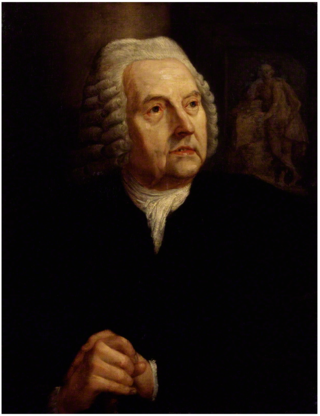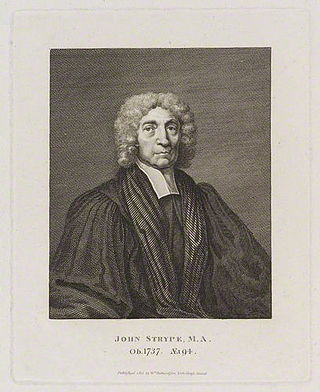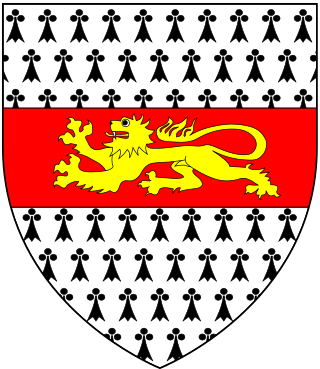Related Research Articles

Peter Scheemakers or Pieter Scheemaeckers II or the Younger was a Flemish sculptor who worked for most of his life in London. His public and church sculptures in a classicist style had an important influence on the development of modern sculpture in England.

John Strype was an English clergyman, historian and biographer from London. He became a merchant when settling in Petticoat Lane. In his twenties, he became perpetual curate of Theydon Bois, Essex and later became curate of Leyton; this allowed him direct correspondence with several highly notable ecclesiastical figures of his time. He wrote extensively in his later years.

Ravenstone is a village and civil parish in the unitary authority area of the City of Milton Keynes, Buckinghamshire, England. The village is about 2.5 miles (4 km) west of Olney, and 4 miles (6.4 km) north of Newport Pagnell and about 10 miles (16 km) from Central Milton Keynes. The 2011 Census recorded the parish population as 209.

Edward Harold Browne was a bishop of the Church of England.

The Seatonian Prize is awarded by the University of Cambridge for the best English poem on a sacred subject. This prize has been awarded annually since 1750 and is open to any Master of Arts of the university. Lord Byron referred to this prize in his 1809 poem entitled "English Bards and Scots Reviewers". The prize is still awarded annually, with a deadline of 30 September each year. It is open to all members of the Senate of the University of Cambridge, and to anyone with the status of Masters of Arts.
Josiah Hort, was an English clergyman of the Church of Ireland who ended his career as archbishop of Tuam.
The Reverend William Lubbock MA BD (Cantab) was an English divine, Fellow of Caius College, Cambridge, and Church of England clergyman. He founded the famous English family of Lubbock.
Henry Cantrell was a high-church Church of England clergyman and religious controversialist.

John Proby was an English Member of Parliament for Huntingdonshire (1722–27) and Stamford (1743–47).
Charles James Hoare was an evangelical Church of England clergyman, archdeacon of Surrey.
Isaac Milles or Mills was an English cleric, often described as the model parish priest of that day.
Thomas Paske was an English clergyman and academic, deprived as a royalist.
Simon Lowth (1636–1720) was an English nonjuring clergyman, nominated by James II as Dean of Rochester, and later a controversialist on the position of bishops.
John Mason (1646?–1694) was a Calvinistic Anglican priest, poet and hymn-writer.
Brampton Gurdon was an English clergyman and academic, Boyle lecturer in 1721.
Owen Manning (1721–1801) was an English clergyman and antiquarian, known as a historian of Surrey.

John Lewis was an English clergyman and antiquary.
Charles Frederic Watkins (1794–1873) was an Anglican clergyman, best known for his work in restoring the parish church of Brixworth, Northamptonshire, and promoting the study of its origins.
Charles Longueville was a British lawyer and Tory and later Whig politician who sat in the House of Commons from 1715 to 1741.

Sir Thomas Parkyns, 2nd Baronet was an English writer, landowner, architect and engineer who was a prominent figure in British wrestling during the Georgian era.
References
- ↑ "Seaton, Thomas (STN701T)". A Cambridge Alumni Database. University of Cambridge.
- Thompson Cooper, 'Thomas Seaton (1684–1741), Church of England clergyman and religious writer', revised by S. J. Skedd, in Oxford Dictionary of National Biography (OUP, Oxford, 2004)
- William Camden's Britannia, new ed. by Richard Gough in three volumes (1789), volume 2, page 177